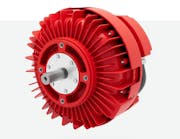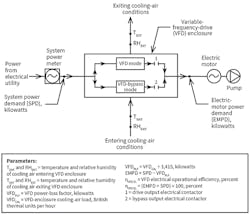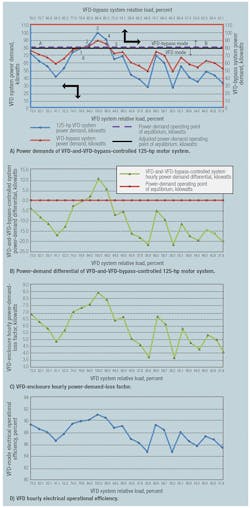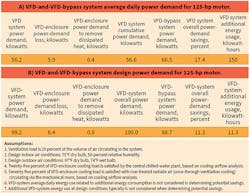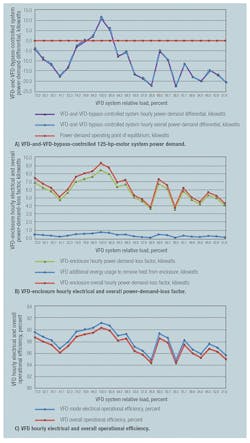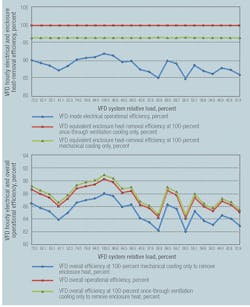During off-design load conditions, use of variable-frequency drives (VFDs) reduces electric-motor power demand. At design and near-design loads, however, it has the opposite effect. Widespread application of VFDs, then, might cause an increase in the design power demand of electric utilities, forcing them to administer mandatory consumer power-demand-shedding programs. An increase in design power demand over installed power capacity might lead to other negative consequences, such as electric-utility power outages, consumer productivity losses, and increased environmental pollution. This article demonstrates how automatic switchover from VFD control mode to VFD-bypass control mode and back can help to mitigate, if not eliminate, these negative impacts.
Power-Demand Control and Monitoring System
The control and monitoring system employed in our investigation is shown in Figure 1. The system was capable of carrying out automatic switchover from pump electric-motor VFD control mode to VFD-bypass control mode and back to VFD control mode. The switchover was executed at certain system power-demand magnitudes, which were the same for both operational modes at given motor loads. System power demand was metered and monitored with a dedicated power meter installed ahead of the drive frequency converter.
VFD variable power-demand-loss factor was determined through continual monitoring of the temperature and relative humidity of cooling air entering and exiting the VFD enclosure.1, 2
System power demand (SPD) (kilowatts) was found via direct reading of the dedicated power meter, while electric-motor power demand (EMPD) (kilowatts) was calculated as the difference between SPD and VFD-enclosure power-loss factor (VFDPLF) (kilowatts).
VFD overall operational efficiency (ηOVR) (percent) was presented as the product of VFD electrical efficiency (ηELC) (percent) and VFD-enclosure heat-removal efficiency (ηHRE) (percent):
ηOVR = ηELC × ηHRE
VFD electrical efficiency was calculated using the following equation:
ηELC = [([SPD – (VFDPLF × VFDAHT) − CFPD]) ÷ SPD] × 100
where:
VFDAHT = VFD-enclosure direct heat-transfer loss to ambient cooling air via forced convection, estimated to be 3 percent added to the monitored VFD-enclosure power-loss factor based on empirical analysis
CFPD = VFD-enclosure cooling-fan power demand, kilowatts
VFD-enclosure heat-removal efficiency was calculated using the following equation:
ηHRE = [([SPD – EMPD] ÷ COPOVR) ÷ (VFDPLF × VFDAHT)] × 100
where:
COPOVR = overall VFD-enclosure cooling-system (chiller plant, air-handling units, etc.) coefficient of performance
In Figure 1, when Contactor 1 is open and Contactor 2 is closed, the system is in VFD mode. When Contactor 1 is closed and Contactor 2 is open, the system is in VFD-bypass mode.
Switchover Transition Time
To avoid loss of load under low-inertia conditions, switchover from VFD mode to VFD-bypass mode and back must occur over relatively short periods, which for water pumps is less than 1 sec. The technical protocol for VFD systems, however, does not include this requirement. Switchover of the secondary-loop chilled-water pump from VFD mode to VFD-bypass mode required about 7 sec, while switchover from VFD-bypass mode back to VFD mode took nearly 20 sec. The overall duration of the switchover led to the pump being shut down on insufficient pressure differential (after about 2 sec) and the chiller being shut down on insufficient water flow, which led to the restarting of the pump and chiller by the building automation system.
Experts in the field claim a standard drive switchover in either direction should take no longer than 200 millisec (0.2 sec) to complete, considering the contactor’s transition time.
Currently, if something goes wrong, a VFD is switched to bypass mode manually; once the problem is corrected, the VFD is switched back manually. In the event of a high-inertia load (such as a fan of an air-handling unit), switchover from VFD mode to VFD-bypass mode can be accomplished with a so-called “flying start” circuit without a loss of load. For a low-inertia system (i.e., with water pumps) and/or highly viscous liquids (i.e., more viscous than water), the switchover transient period should be minimized to avoid loss of load.
Power-Demand and Electrical-Energy-Use Reduction
The system consisted of a 125-hp secondary chilled-water-loop pump and multiple air-handling units with the following design parameters:
- Relative system dynamic-pressure drop of approximately 0.7.
- Relative system static-pressure drop of approximately 0.3.3
- Secondary-loop design chilled-water-system specific flow rate of 2.4 gpm per ton.
- System temperature differential of 10°F.
Figure 2 shows system operational parameters for a typical weekday electrical load. Hourly kilowatt measurements were averaged. The equilibrium power-demand values4 for variable-speed motor control (VFD mode) and constant-speed motor control (VFD-bypass mode), represented by the straight dashed line going through points A and B in Figure 2A, represent the intersection of system power-demand values (points 1 and 5 in Figure 2A).
VFD-mode maximum metered power demand was about 99.2 kW (Point 3 in Figure 2A), while VFD-bypass-mode maximum metered power demand was close to 88.7 kW, or about 89.4 percent of VFD-mode maximum metered power demand.
In Figure 2A, relative load is the ratio of current VFD-mode power demand to maximum VFD-mode power demand. The equilibrium power-demand-operating-point motor load of 79.2 kW was close to the relative load of 80 percent for both operational modes. In VFD-bypass mode, a drop in motor speed of nearly 20 percent was needed to reach the power-demand equilibrium.
The rotating control went through three operational modes:
- Mode 1: In VFD mode, as long as system power demand was equal to or lesser than 79.2 kW (i.e., varied along or went below the straight dashed line in Figure 2A), the control system would continue to run the motor in VFD mode. When system power demand went above 79.2 kW (i.e., moved to Point 2, located above the dashed line, in Figure 2A), the control system would switch the motor to VFD-bypass mode.
- Mode 2: When motor power demand at constant frequency and speed fell below power demand at the point of equilibrium (i.e., fell below points 1 and 5 on the dashed line in Figure 2A), the control system would switch motor operation from VFD-bypass mode to VFD mode.
- Mode 3: When motor power demand at constant frequency and speed was equal to or greater than the power demand at the point of equilibrium (i.e., traveled along or moved above the dashed straight line in Figure 2A to points 2, 3, or 4), the control system would continue running the motor at constant frequency and speed.
The three operational modes are defined by the following equations:
Mode 1: MLVFD + VFDPLF > MLCS
Mode 2: MLVFD + VFDPLF = MLCS
Mode 3: MLVFD + VFDPLF < MLCS
where:
MLVFD = electric-motor power-demand load during VFD mode, kilowatts
VFDPLF = VFD-enclosure power-demand-loss factor during VFD-controlled electric-motor mode, kilowatts
MLCS = electric-motor power-demand load during motor constant-speed mode (VFD-bypass mode), kilowatts.
For a VFD without enclosure or monitoring capability, cooling load could be projected and incorporated into a control strategy based on system design parameters (e.g., dynamic and static pressure losses).3
The suggested switchover control points (dashed line in Figure 2A) were selected conservatively because switchover should be executed below the dashed line (see adjusted power-demand operating point of equilibrium), as shown by the solid line in Figure 2A.
The VFD-mode power-demand values in Figure 2A were taken from power-meter readings. Most of the VFD-bypass-mode power-demand values were taken from the same readings; a few of the intermediate values were found by interpolating metered power-demand readings at constant frequency current and motor speed.
At the load profile in Figure 2A, a reduction in power demand occurred during the 3-hr period above the power-demand equilibrium (dashed line). The savings were found by subtracting the VFD-bypass-mode power-demand values above the operating point of equilibrium (shown in red in Figure 2A) from the respective VFD-mode values (shown in blue in Figure 2A—points 2, 3, and 4).
The cumulative overall power-demand reduction in VFD-bypass mode was 22.0 kW ([99.2 − 88.7] + 0.8 + [89.9 − 84.5] + 0.7 + [83.3 − 79.4] + 0.65), leading to additional electrical-energy savings of 22 kWh over the 3-hr period), taking into account the additional power demand of 2.15 kW associated with the removal of heat dissipated into the VFD enclosure. Total VFD-mode power demand for the same 3-hr period was 274.6 kW, compared with the VFD-bypass-mode power demand of 252.6 kW. Thus, the cumulative power-demand savings during the 3 hr of VFD-bypass operation resulted in approximately 8-percent power-demand reduction.
VFD-mode average daily power-demand reduction is an estimated 17.4 percent (Table 1A). VFD mode requires an additional 150 kWh of energy to compensate for VFD-enclosure power-demand loss and to remove heat that dissipated into the enclosure. This additional energy typically is not considered in calculations of potential savings, leading to overestimation of savings.
VFD- and VFD-bypass-mode design operational parameters are shown in Table 1B. Design power-demand savings from the application of VFD-bypass control amounted to 11.3 percent (i.e., 11.3 kW, or 0.086 kW per horsepower related to motor design horsepower and nearly 0.17 kWh of additional energy per average motor-horsepower load). Daily relative average energy use will be higher at lower motor-horsepower loads because of reduced VFD and motor efficiency.
For systems with higher percentages of enclosure mechanical-cooling load and lower utilization of once-through ventilation cooling, VFD-bypass power-demand savings will be higher than in Table 1B. This is because of the additional electrical energy needed to remove heat from VFD enclosures. VFDs with design system dynamic- and static-pressure-loss ratios lower than 0.7 and 0.3, respectively, will have lesser power-demand savings in VFD-bypass mode.
Figure 2B shows power-demand differential minus the additional electrical energy used to remove heat that dissipated into the VFD enclosure. The figure also shows the power-demand operating point of equilibrium. Power-demand differentials above this line indicate power-demand savings (maximum of 10.5 kW) in VFD-bypass mode. Power-demand differentials below this line indicate power-demand savings (maximum of 21.7 kW) in VFD mode.
Figure 2C shows magnitudes of daily VFD-enclosure power-demand-loss-factor variations. Power-demand-loss factor varies from about 8.4 kW at 100-percent VFD relative load to 3.7 kW at 26-percent relative load.
Figure 2D shows operational efficiency calculated based on metered and averaged system power demand and monitored VFD-enclosure cooling load and power-loss factor (Figure 1). VFD relative load varied from 26 percent to 100 percent, averaging 56.7 percent, while VFD electrical operational efficiency varied from about 85 percent to 91.8 percent, averaging nearly 88.5 percent.
VFD Overall Operational Efficiency
Figure 3 shows VFD-mode daily operational parameters correlated with data in Figure 2A.
Figure 3A illustrates increased overall power-demand differential between VFD-bypass and VFD control from the additional electrical energy needed to remove heat from the VFD enclosure. Because of that, power-demand differential between VFD-bypass and VFD operation is increased (maximum savings of 11.3 kW), while power-demand differential between VFD and VFD-bypass operation is reduced (maximum savings of 21.5 kW).
Figure 3B shows VFD-enclosure hourly electrical and overall power-demand-loss factor. Overall power-demand-loss factor represents the summation of VFD-enclosure power-demand-loss factor and the additional power needed to remove heat dissipated into the enclosure (maximum value of 0.82 kW, with average daily value of 0.42 kW). Overall maximum power-demand-loss factor increased to nearly 9.3 kW.
Figure 3C shows overall VFD operational efficiency will be lower than the electrical VFD efficiency in Figure 2D by about 1 percent at 100-percent VFD relative load. Average hourly overall VFD operational efficiency will drop by nearly 0.8 percent, from 88.5 percent to 87.7 percent.
Figure 4 illustrates the impact of system electrical energy used to remove heat from a VFD enclosure on overall VFD efficiency. The heat-removal-system efficiency shown in the top graph in Figure 4 is very high, varying from 99.7 percent to 99.74 percent for all considered VFD-system relative loads in the once-through ventilation cooling base-case scenario. Overall VFD efficiencies are shown for two options:
- 100 percent of once-through ventilation cooling used to remove heat from a VFD enclosure.
- 100 percent of mechanical cooling from a central chilled-water plant used to remove heat from a VFD enclosure.
The bottom graph in Figure 4 shows the application of 100-percent once-through ventilation cooling increases VFD overall hourly daily efficiency at 100 percent and 26.5 percent of VFD relative load by 0.65 percent and 0.38 percent, respectively, compared with the base-case scenario. The bottom graph in Figure 4 also shows the application of 100-percent mechanical cooling leads to a reduction in VFD overall hourly daily efficiency at 100 percent and 26.5 percent of VFD relative load by about 2.4 percent, compared with the base-case scenario.
Conclusion
The application of VFDs improves the controllability and reduces the power demand and electrical-energy consumption of electric motors during off-design load conditions. During design and near-design conditions, however, it increases system power demand. Additionally, over the entire spectrum of loads, it increases the electrical-energy use of VFD systems with or without enclosures.
The application of automatic switchover from VFD mode to VFD-bypass mode and back optimizes the control and energy efficiency of pump electric motors during both design and off-design operational conditions via application of variable- and constant-frequency-current systems. This optimized control can result in power-demand reduction for electrical-energy users as well as electric utilities. A study of a 125-hp electric motor with metered power demand shows a significant reduction in design power demand per motor design horsepower (11.3 kW, or 0.09 kW per horsepower).
Additional electrical energy needed to remove heat dissipated into a VFD enclosure must be considered during feasibility studies to evaluate VFD operational efficiency properly.
VFD actual electrical efficiency varied from 85 percent to 91.8 percent, with an average daily value of 88.5 percent. Compared with VFD electrical efficiency only, overall average VFD operational efficiency was lower by about 0.8 percent.
Our investigation demonstrated potential power-demand savings of 22 kW over three hours of VFD-bypass operation, as well as energy-use reduction of 22 kWh. During design conditions, the reduction in power demand might enable electrical utilities to avoid or shorten the duration of mandatory power-demand-shedding periods, increasing industrial and commercial customers’ production output and improving their economic viability. This will increase overall power-supply reliability for all electrical-energy consumers. For electrical utilities, it might allow the delay or reduction of capital investments.
For low-inertia applications, transition time must be shortened to prevent loss of load during switchover.
The application of switchover control is recommended for electrical utilities with low power-demand reserves.
Lastly, switchover control will reduce pollutants, including nitrogen oxides, sulfur dioxide, nuclear-waste materials, and carbon dioxide, at electric-utility power-generation plants.
References
- Burd, A.L., & Burd, G.S. (2015, February). VFD-enclosure variable cooling load, part 1 of 2. HPAC Engineering, pp. 24-30.
- Burd, A.L., & Burd, G.S. (2015, March). VFD-enclosure variable cooling load, part 2 of 2. HPAC Engineering, pp. 32-38.
- Burd, A.L., & Burd, G.S. (2014, August). Evaluating power-demand reduction with VFD-controlled systems. HPAC Engineering, pp. 22-29.
- Burd, A.L., & Burd, G.S. (2012, March). U.S. Patent No. 8,143,819 B2. Washington, DC: U.S. Patent and Trademark Office.
Alexander L. Burd, PhD, PE, is president of, and Galina S. Burd, MS, is a project manager for, Advanced Research Technology, an engineering and research consulting firm. Alexander has 35 years of experience in the design, research, and optimization of HVAC and district power systems for large facilities and energy utilities and has had more than 35 research and technical papers published in American and European journals. Galina has more than 25 years of design and research experience in HVAC and architectural engineering and has coauthored many technical and research papers in American journals. Together, Alexander and Galina have authored three U.S. patents related to energy conservation. They can be contacted at [email protected].
Did you find this article useful? Send comments and suggestions to Executive Editor Scott Arnold at [email protected].
